Environmental Implications of the National Power Roadmap with Policy Directives for Battery Electric Vehicles (BEVs)
Abstract
:1. Introduction
2. Materials and Methods
2.1. Environmental Impact Using Life Cycle Assessment
2.1.1. Goal and Scope Definition
2.1.2. Energy Efficiency of ICEV and BEV
2.1.3. Life Cycle Inventory and Impact Assessment
2.2. National Power Mix and Roadmap in Korea
2.3. Environmental Benefits of BEVs Commuting in Megacities
3. Results
3.1. Environmental Impact of the Korean National Power Roadmap
3.2. Environmental Performance of BEVs Compared to ICEVs
3.3. Environmental Implications of Using BEVs for Commuting in Seoul Megacity
4. Discussion
5. Conclusions
Author Contributions
Funding
Conflicts of Interest
Appendix A
Appendix A.1. Technical Specifications and Sales of BEVs in Korea
| Battery Electric Vehicles | Battery2 Capacity (kWh) | Vehicle Range (km) | Energy Efficiency (km/kWh) | Sales (Unit) (Market Share, %) | |||||
|---|---|---|---|---|---|---|---|---|---|
| Manufacturer | Model | Temperate Condition | Freezing Condition | Typical Driving | City Driving | Highway Driving | In 2016 | In 2017 | |
| KIA | Ray EV | 16.4 | 91 | 69.3 | 5.0 | 5.4 | 4.6 | 9 (0.1) | 38 (0.3) |
| Renault Samsung | SM3 Z.E. | 22 | 135 | 83.5 | 4.4 | 4.8 | 4.0 | 623 (9.8) | 2014 (15.7) |
| Chevrolet | Bolt EV | 60.0 | 383 | 266 | 5.5 | 6.0 | 5.1 | 98 (1.5) | 563 (4.4) |
| BMW | i3 94Ah | 18.8 | 132 | 75.5 | 5.9 | 6.4 | 5.3 | 369 (5.8) | 191 (1.5) |
| KIA | Soul EV | 27 | 148 | 123.7 | 5.2 | 6.0 | 4.5 | 860 (13.5) | 2051 (16.0) |
| Nissan | LEAF | 21.3 | 132 | 85.5 | 5.2 | 5.7 | 4.7 | 88 (1.4) | 47 (0.4) |
| Hyundai | IONIQ electric | 28 | 191 | 155 | 6.3 | 6.9 | 5.8 | 4323 (67.9) | 7932 (61.8) |
| Average | 21.7 | 136.7 | 96.5 | 5.36 | 5.89 | 4.86 | - | - | |
| Total sales | - | - | - | - | - | - | 6370 | 12,836 | |
| Combined average energy efficiency (km/kWh) | 5.9 | 5.8 | |||||||
Appendix A.2. Normalization and Weighting Factors by Environmental Impact Factor
| Impact Category | Unit | Normalization Factor | Weighting Factor |
|---|---|---|---|
| ADP | kg yr−1 | 24.9 | 0.06 |
| AP | kg SO2e | 39.8 | 0.05 |
| EP | kg PO43−e | 13.1 | 0.1 |
| GWP | kg CO2e | 5530 | 0.25 |
| HTP | kg 1,4DCBe | 1480 | 0.08 |
| ODP | kg CFC11e | 0.0407 | 0.04 |
| POCP | kg ethylene-e | 10.3 | 0.06 |
| PM | kg PMe | 1.2 | 0.05 |
Appendix A.3. The BEVs Penetration Plans by State in Seoul Megacity
| Year | Seoul (Units) | Incheon (Units) | Gyeonggi (Units) | Total (Units) |
|---|---|---|---|---|
| 2022 | 48,465 | 14,000 | 30,000 | 92,465 |
| 2025 | 85,465 | 24,688 | 52,903 | 163,056 |
Appendix A.4. Environmental Impact of the National Power Mix by Energy Source
| Impact Category | Unit | Hydro Power | Steam Power | Combined Power | Nuclear Power | Renewable Power | ||
|---|---|---|---|---|---|---|---|---|
| Reservoir | Anthracite Coal | Bituminous Coal | Heavy Oil | LNG | Solar PV 20 Years | |||
| ADP | kg yr−1 | 1.06 | 2.59 | 8.98 | 6.07 | 2.92 | 2.53 | 2.90 |
| AP | kg SO2e | 5.15 | 1.23 | 1.60 | 1.89 | 5.75 | 1.80 | 3.71 |
| EP | kg PO43−e | 8.73 | 2.19 | 8.59 | 1.77 | 4.93 | 5.21 | 9.39 |
| GWP | kg CO2e | 3.61 | 1.32 | 1.16 | 8.05 | 4.58 | 6.25 | 5.36 |
| HTP | kg 1,4DCBe | 1.25 | 4.68 | 6.36 | 8.77 | 1.13 | 2.66 | 3.24 |
| ODP | kg CFC11e | 3.16 | 3.21 | 9.08 | 6.06 | 5.75 | 1.45 | 9.60 |
| POCP | kg ethylene-e | 1.34 | 1.55 | 2.20 | 6.80 | 1.02 | 4.20 | 1.12 |
| PM | kg PMe | 7.78 | 5.62 | 6.40 | 8.98 | 3.76 | 5.70 | 4.74 |
| Weighted environmental impact | 4.13 (2.8) | 4.97 (33.6) | 1.48 (100.0) | 4.76 (32.2) | 2.63 (17.8) | 5.13 (3.5) | 1.36 (9.2) | |
Appendix A.5. Environmental Impact of the ICEVs
| Impact Category | Unit | Gasoline | Diesel | ||||
|---|---|---|---|---|---|---|---|
| Production (%) | Combustion (%) | Total (%) | Production (%) | Combustion (%) | Total (%) | ||
| ADP | 1/yr | 2.06 (100.0) | 0 (0.0) | 2.06 (100.0) | 2.28 (100.0) | 0 (0.0) | 2.28 (100.0) |
| AP | kg SO2-eq | 1.44 (1.5) | 9.28 (98.5) | 9.42 (100.0) | 1.21 (0.5) | 2.24 (99.5) | 2.25 (100.0) |
| EP | kg PO43−-eq | 1.07 (0.6) | 1.72 (99.4) | 1.73 (100.0) | 8.28 (0.2) | 4.18 (99.8) | 4.19 (100.0) |
| GWP | kg CO2-eq | 6.45 (2.7) | 2.30 (97.3) | 2.37 (100.0) | 5.91 (2.0) | 2.97 (98.0) | 3.03 (100.0) |
| HTP | kg 1,4DCB eq | 3.03 (85.1) | 5.33 (15.0) | 3.57 (100.0) | 1.87 (0.7) | 2.54 (99.3) | 2.56 (100.0) |
| ODP | kg CFC 11-eq | 1.66 (100.0) | 0 (0.00) | 1.66 (100.0) | 9.08 (100.0) | 0 (0.0) | 9.08 (100.0) |
| POCP | kg ethylene eq | 1.33 (1.2) | 1.11 (98.8) | 1.12 (100.0) | 9.66 (0.1) | 9.04 (99.9) | 9.05 (100.0) |
| PM | kg PM | 7.48 (63.1) | 4.38 (36.9) | 1.19 (100.0) | 6.25 (13.4) | 4.03 (86.6) | 4.66 (100.0) |
| Weighted environmental impact | 5.59 (29.0%) | 1.37 (71.0%) | 1.93 (100.0%) | 6.06 (18.6%) | 2.65 (81.4%) | 3.26 (100.0%) | |
Appendix A.6. Environmental Performance of BEVs Compared with ICEVs
| Impact Category | Unit | Gasoline Vehicle | Diesel Vehicle | Electric Vehicle | ||||
|---|---|---|---|---|---|---|---|---|
| In 2016 | In 2017 | In 2022 | In 2025 | In 2030 | ||||
| ADP | kg yr−1 | 1.47 | 1.19 | 8.59 | 7.06 | 2.62 | 2.84 | 3.22 |
| AP | kg SO2e | 6.75 | 1.17 | 1.46 | 1.60 | 1.28 | 1.20 | 1.17 |
| EP | kg PO43−e | 1.24 | 2.19 | 6.73 | 7.78 | 4.30 | 3.86 | 3.50 |
| GWP | kg CO2e | 1.70 | 1.58 | 1.00 | 1.15 | 8.73 | 8.03 | 7.44 |
| HTP | kg 1,4DCBe | 2.56 | 1.34 | 5.15 | 5.91 | 3.33 | 3.02 | 2.78 |
| ODP | kg CFC11e | 1.19 | 4.74 | 1.22 | 1.28 | 3.80 | 4.74 | 6.37 |
| POCP | kg ethylene | 8.02 | 4.73 | 2.16 | 1.81 | 5.91 | 5.90 | 5.69 |
| PM | kg PMe | 1.24 | 2.43 | 5.43 | 6.17 | 3.59 | 3.27 | 3.02 |
| Weighted environmental impact | 1.40 (1.00) | 1.70 (1.22) | 1.55 (1.10) | 1.74 (1.24) | 1.17 (0.83) | 1.07 (0.77) | 1.01 (0.72) | |
Appendix A.7. Environmental Implications of BEVs for Commuting in a Megacity
| Year | Scenario 1 (RR-BEV) | Scenario 2 (PR-ICEV) | Scenario 3 (PR-DSEL) |
|---|---|---|---|
| GHG emissions (ton/year) | |||
| 2016 | 8,176,878 | ||
| 2022 | 8,129,423 | 7,995,587 | 8,080,435 |
| 2025 | 8,084,609 | 7,805,457 | 8,009,246 |
| 2030 | 3,665,737 | ||
| PM emissions (ton/year) | |||
| 2016 | 808.0 | ||
| 2022 | 818.5 | 834.7 | 821.2 |
| 2025 | 823.4 | 837.6 | 822.1 |
| 2030 | 1488.0 | ||
References
- Miotti, M.; Supran, G.J.; Kim, E.J.; Trancik, J.E. Personal vehicles evaluated against climate change mitigation targets. Environ. Sci. Technol. 2016, 50, 10795–10804. [Google Scholar] [CrossRef] [PubMed]
- Lucas, A.; Silva, C.A.; Neto, R.C. Life cycle analysis of energy supply infrastructure for conventional and electric vehicles. Energy Policy 2012, 41, 537–547. [Google Scholar] [CrossRef]
- Green, E.H.; Skerlos, S.J.; Winebrake, J.J. Increasing electric vehicle policy efficiency and effectiveness by reducing mainstream market bias. Energy Policy 2014, 65, 562–566. [Google Scholar] [CrossRef]
- Zhang, X.; Bai, X.; Shang, J. Is subsidized electric vehicles adoption sustainable: Consumers’ perceptions and motivation toward incentive policies, environmental benefits, and risks. J. Clean. Prod. 2018, 192, 71–79. [Google Scholar] [CrossRef]
- Bloomberg. Electric Vehicle Outlook 2017; Bloomberg New Energy: New York, NY, USA, 2017. [Google Scholar]
- IEA; Ministerial, C.E.; Initiative, E.V. Global EV outlook 2017; Electric Vehicles Initiative: Paris, France, 2016. [Google Scholar]
- Seok, J. Legal and System Improvement and Support System of Leading Countries for Establishment of Charging Infrastructure for Electric Vehicle; Korea Energy Economics Institute: Ulsan, Korea, 2016. [Google Scholar]
- Upadhyay, A.; Wilson, I. Electric Vehicles Could Displace 8 Million Barrels of Oil Per Day by 2040; Bloomberg: New York, NY, USA, 2017. [Google Scholar]
- Sioshansi, R.; Denholm, P. Emissions impacts and benefits of plug-in hybrid electric vehicles and vehicle-to-grid services. Environ. Sci. Technol. 2009, 43, 1199–1204. [Google Scholar] [CrossRef] [PubMed]
- Onat, N.C.; Kucukvar, M.; Tatari, O. Conventional, hybrid, plug-in hybrid or electric vehicles? State-based comparative carbon and energy footprint analysis in the United States. Appl. Energy 2015, 150, 36–49. [Google Scholar] [CrossRef]
- Van Mierlo, J.; Messagie, M.; Rangaraju, S. Comparative environmental assessment of alternative fueled vehicles using a life cycle assessment. J. Transp. Res. Procedia 2017, 25, 3435–3445. [Google Scholar] [CrossRef]
- Barkenbus, J. Electric Vehicles: Climate Saviors, or Not? Issues Sci. Technol. 2017, 33, 55. [Google Scholar]
- Ou, X.; Yan, X.; Zhang, X. Using coal for transportation in China: Life cycle GHG of coal-based fuel and electric vehicle, and policy implications. Int. J. Greenh. Gas Control 2010, 4, 878–887. [Google Scholar] [CrossRef]
- Ma, Y.; Ke, R.-Y.; Han, R.; Tang, B.-J. The analysis of the battery electric vehicle’s potentiality of environmental effect: A case study of Beijing from 2016 to 2020. J. Clean. Prod. 2017, 145, 395–406. [Google Scholar] [CrossRef]
- Ellingsen, L.A.W.; Majeau-Bettez, G.; Singh, B.; Srivastava, A.K.; Valøen, L.O.; Strømman, A.H. Life cycle assessment of a lithium-ion battery vehicle pack. J. Ind. Ecol. 2014, 18, 113–124. [Google Scholar] [CrossRef]
- Noori, M.; Gardner, S.; Tatari, O. Electric vehicle cost, emissions, and water footprint in the United States: development of a regional optimization model. Energy 2015, 89, 610–625. [Google Scholar] [CrossRef]
- Tropschuh, P.F.; Biendl, M. Audi: Raw Materials, Road, Recycling—How Life Cycle Analysis Influences Product Development. In Sustainable Value Chain Management; CSR, Sustainability, Ethics & Governance; Springer: Berlin, Germany, 2015; pp. 167–183. [Google Scholar] [CrossRef]
- Casals, L.C.; Martinez-Laserna, E.; García, B.A.; Nieto, N. Sustainability analysis of the electric vehicle use in Europe for CO2 emissions reduction. J. Clean. Prod. 2016, 127, 425–437. [Google Scholar] [CrossRef]
- Tessum, C.W.; Marshall, J.D.; Hill, J.D. A spatially and temporally explicit life cycle inventory of air pollutants from gasoline and ethanol in the United States. Environ. Sci. Technol. 2012, 46, 11408–11417. [Google Scholar] [CrossRef]
- Tessum, C.W.; Hill, J.D.; Marshall, J.D. Life cycle air quality impacts of conventional and alternative light-duty transportation in the United States. Proc. Natl. Acad. Sci. USA 2014, 111, 18490–18495. [Google Scholar] [CrossRef]
- Hawkins, T.R.; Singh, B.; Majeau-Bettez, G.; Strømman, A.H. Comparative environmental life cycle assessment of conventional and electric vehicles. J. Ind. Ecol. 2013, 17, 53–64. [Google Scholar] [CrossRef]
- Spielmann, M.; Althaus, H.-J. Can a prolonged use of a passenger car reduce environmental burdens? Life Cycle analysis of Swiss passenger cars. J. Clean. Prod. 2007, 15, 1122–1134. [Google Scholar] [CrossRef]
- Dewulf, J.; Van der Vorst, G.; Denturck, K.; Van Langenhove, H.; Ghyoot, W.; Tytgat, J.; Vandeputte, K. Recycling rechargeable lithium ion batteries: Critical analysis of natural resource savings. Resour. Conserv. Recycl. 2010, 54, 229–234. [Google Scholar] [CrossRef]
- Kim, S.-K. Changing lifestyles and consumption patterns of the South Korean middle class and new generations. In Consumption in Asia; Routledge: London, UK, 2002; pp. 77–97. [Google Scholar]
- Sonnenschein, J.; Mundaca, L. Decarbonization under green growth strategies? The case of South Korea. J. Clean. Prod. 2016, 123, 180–193. [Google Scholar] [CrossRef]
- Oliver, J.D.; Lee, S.-H. Hybrid car purchase intentions: a cross-cultural analysis. J. Consum. Mark. 2010, 27, 96–103. [Google Scholar] [CrossRef]
- Curran, M.A. Environmental life-cycle assessment. Int. J. Life Cycle Assess. 1996, 1, 179. [Google Scholar] [CrossRef]
- Guinée, J.B. Handbook on life cycle assessment operational guide to the ISO standards. Int. J. Life Cycle Assess. 2002, 7, 311. [Google Scholar] [CrossRef]
- Labuschagne, C.; Brent, A.C. Sustainable project life cycle management: the need to integrate life cycles in the manufacturing sector. Int. J. Proj. Manag. 2005, 23, 159–168. [Google Scholar] [CrossRef]
- Hertwich, E.G. Life cycle approaches to sustainable consumption: a critical review. Environ. Sci. Technol. 2005, 39, 4673–4684. [Google Scholar] [CrossRef]
- Campanari, S.; Manzolini, G.; De la Iglesia, F.G. Energy analysis of electric vehicles using batteries or fuel cells through well-to-wheel driving cycle simulations. J. Power Sources 2009, 186, 464–477. [Google Scholar] [CrossRef]
- Orecchini, F.; D’Orazio, A.; Valitutti, V.; Fiori, C. Renewability of Energy Resources, Energy Vectors, and Energy Technologies for Mobility. In Handbook of Sustainable Engineering; Springer: Berlin, Germany, 2013. [Google Scholar] [CrossRef]
- Demirdöven, N.; Deutch, J. Hybrid cars now, fuel cell cars later. Science 2004, 305, 974–976. [Google Scholar] [CrossRef]
- To, W.; Lee, P. Diffusion of ISO 14001 environmental management system: global, regional and country-level analyses. J. Clean. Prod. 2014, 66, 489–498. [Google Scholar] [CrossRef]
- KEA. 2016 Vehicle Fuel Economy and CO2 Emissions: Data and Analyses; Korea Energy Agency: Seoul, Korea, 2016. [Google Scholar]
- Girardi, P.; Gargiulo, A.; Brambilla, P.C. A comparative LCA of an electric vehicle and an internal combustion engine vehicle using the appropriate power mix: the Italian case study. Int. J. Life Cycle Assess. 2015, 20, 1127–1142. [Google Scholar] [CrossRef]
- Anair, D.; Mahmassani, A. State of CHARGE; Union of Concerned Scientists (UCS): Cambridge, MA, USA, 2012. [Google Scholar]
- KEITI. Available online: http://www.keiti.re.kr/ (accessed on 24 November 2019).
- ME. Available online: http://www.me.go.kr/ (accessed on 24 November 2019).
- Huppes, G.; van Oers, L.; Pretato, U.; Pennington, D.W. Weighting environmental effects: analytic survey with operational evaluation methods and a meta-method. Int. J. Life Cycle Assess. 2012, 17, 876–891. [Google Scholar] [CrossRef]
- Huppes, G.; Davidson, M.; Kuyper, J.; Van Oers, L.; de Haes, H.U.; Warringa, G. Eco-efficient environmental policy in oil and gas production in The Netherlands. Ecol. Econ. 2007, 61, 43–51. [Google Scholar] [CrossRef]
- KEPCO. Available online: http://home.kepco.co.kr/kepco/ (accessed on 24 November 2019).
- KNREC. New & Renewable Energy Supply Statistics 2016; Korean Energy Associate: Seoul, Korea, 2017. [Google Scholar]
- Ministry of Trade, Industry and Energy. The 8th Basic Plan for Long-term Electricity Supply and Demand (2017–2031); Ministry of Trade, Industry and Energy: Sejong, Korea, 2017.
- Parrish, D.D.; Zhu, T. Clean air for megacities. Science 2009, 326, 674–675. [Google Scholar] [CrossRef] [PubMed]
- Mage, D.; Ozolins, G.; Peterson, P.; Webster, A.; Orthofer, R.; Vandeweerd, V.; Gwynne, M. Urban air pollution in megacities of the world. Atmos. Environ. 1996, 30, 681–686. [Google Scholar] [CrossRef]
- Tiwari, S.; Chate, D.; Srivastava, M.; Safai, P.; Srivastava, A.; Bisht, D.; Padmanabhamurty, B. Statistical evaluation of PM 10 and distribution of PM 1, PM 2.5, and PM 10 in ambient air due to extreme fireworks episodes (Deepawali festivals) in megacity Delhi. Nat. Hazards 2012, 61, 521–531. [Google Scholar] [CrossRef]
- Lee, J.; Taegon, K.; Suh, K. Analysis of Environmental Implications for Eco-friendly Car Technologies and Transportation Policies Considering Commuting Characteristics of Regions. J. Korea Plan. Assoc. 2013, 48, 53–66. [Google Scholar] [CrossRef]
- Ministry of Trade, Industry and Energy. The 7th Basic Plan for Long-term Electricity Supply and Demand (2015–2029); Ministry of Trade, Industry and Energy: Sejong, Korea, 2015.
- ME. The Roadmap of GHG Reduction toward 2030. Available online: http://2030ghg.or.kr/ (accessed on 15 September 2019).
- KOTEMS. Available online: https://www.kotems.or.kr/ (accessed on 24 November 2019).
- Tang, Y.; Zhang, Q.; Li, Y.; Wang, G.; Li, Y. Recycling mechanisms and policy suggestions for spent electric vehicles’ power battery-A case of Beijing. J. Clean. Prod. 2018, 186, 388–406. [Google Scholar] [CrossRef]
- Saxena, S.; Le Floch, C.; MacDonald, J.; Moura, S. Quantifying EV battery end-of-life through analysis of travel needs with vehicle powertrain models. J. Power Sources 2015, 282, 265–276. [Google Scholar] [CrossRef] [Green Version]
- WWEA. Half-Year Report 2011; World Wind Energy Association: Bonn, Germany, 2011; pp. 1–7. [Google Scholar]
- Lu, X.; McElroy, M.B.; Kiviluoma, J. Global potential for wind-generated electricity. Proc. Natl. Acad. Sci. USA 2009, 106, 10933–10938. [Google Scholar] [CrossRef] [Green Version]
- Raadal, H.L.; Gagnon, L.; Modahl, I.S.; Hanssen, O.J. Life cycle greenhouse gas (GHG) emissions from the generation of wind and hydro power. Renew. Sustain. Energy Rev. 2011, 15, 3417–3422. [Google Scholar] [CrossRef]
- Boyle, G. Renewable Energy; Oxford University Press: Oxford, UK, 2004; p. 456. [Google Scholar]
- Tsai, W.-T.; Kuo, K.-C. An analysis of power generation from municipal solid waste (MSW) incineration plants in Taiwan. Energy 2010, 35, 4824–4830. [Google Scholar] [CrossRef]
- Faria, R.; Marques, P.; Moura, P.; Freire, F.; Delgado, J.; de Almeida, A. Impact of the electricity mix and use profile in the life-cycle assessment of electric vehicles. Renew. Sustain. Energy Rev. 2013, 24, 271–287. [Google Scholar] [CrossRef]
- Bhat, I.; Prakash, R. LCA of renewable energy for electricity generation systems—A review. Renew. Sustain. Energy Rev. 2009, 13, 1067–1073. [Google Scholar] [CrossRef]
- KE. Available online: http://www.krx.co.kr/ (accessed on 24 November 2019).
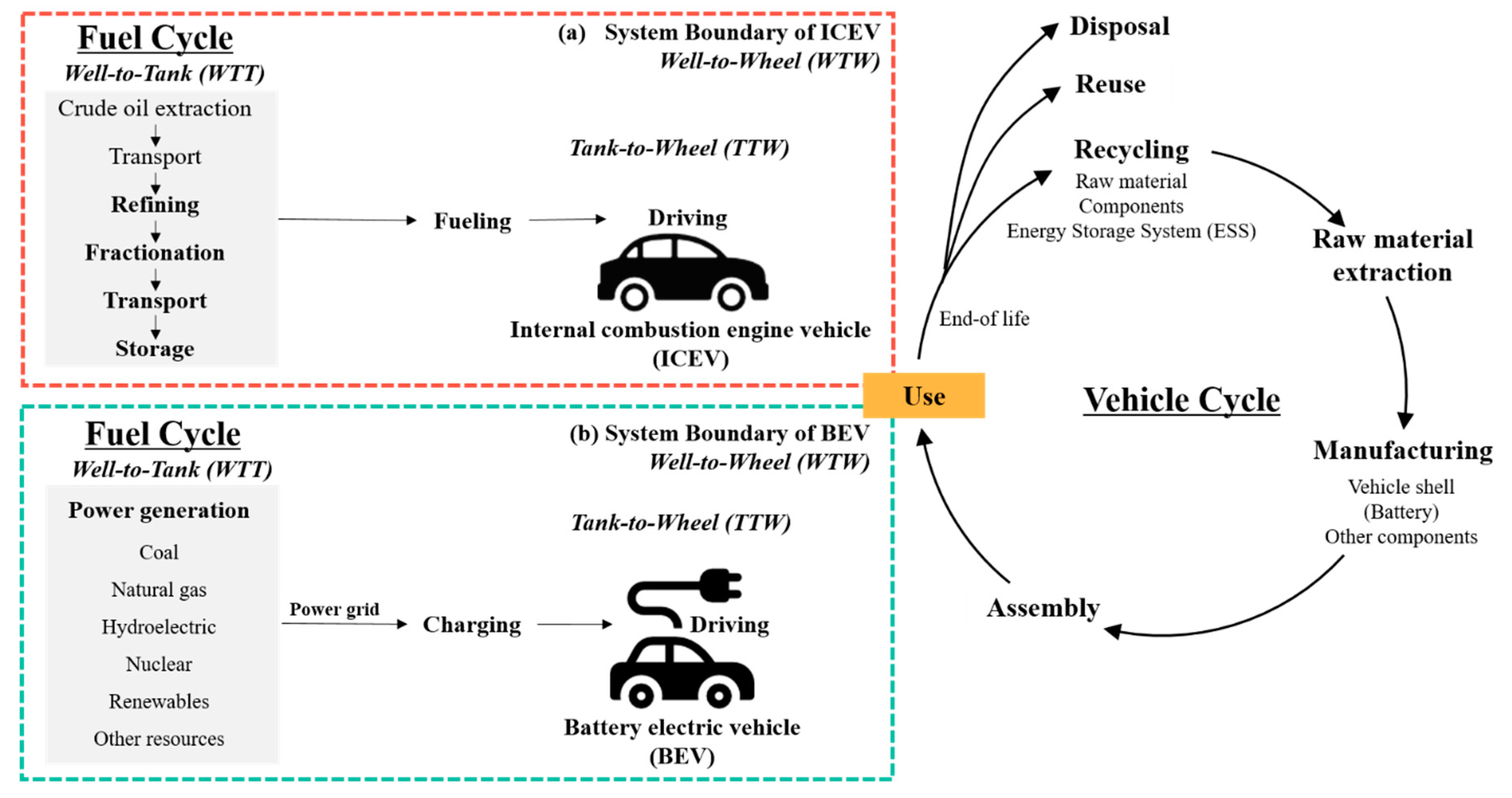

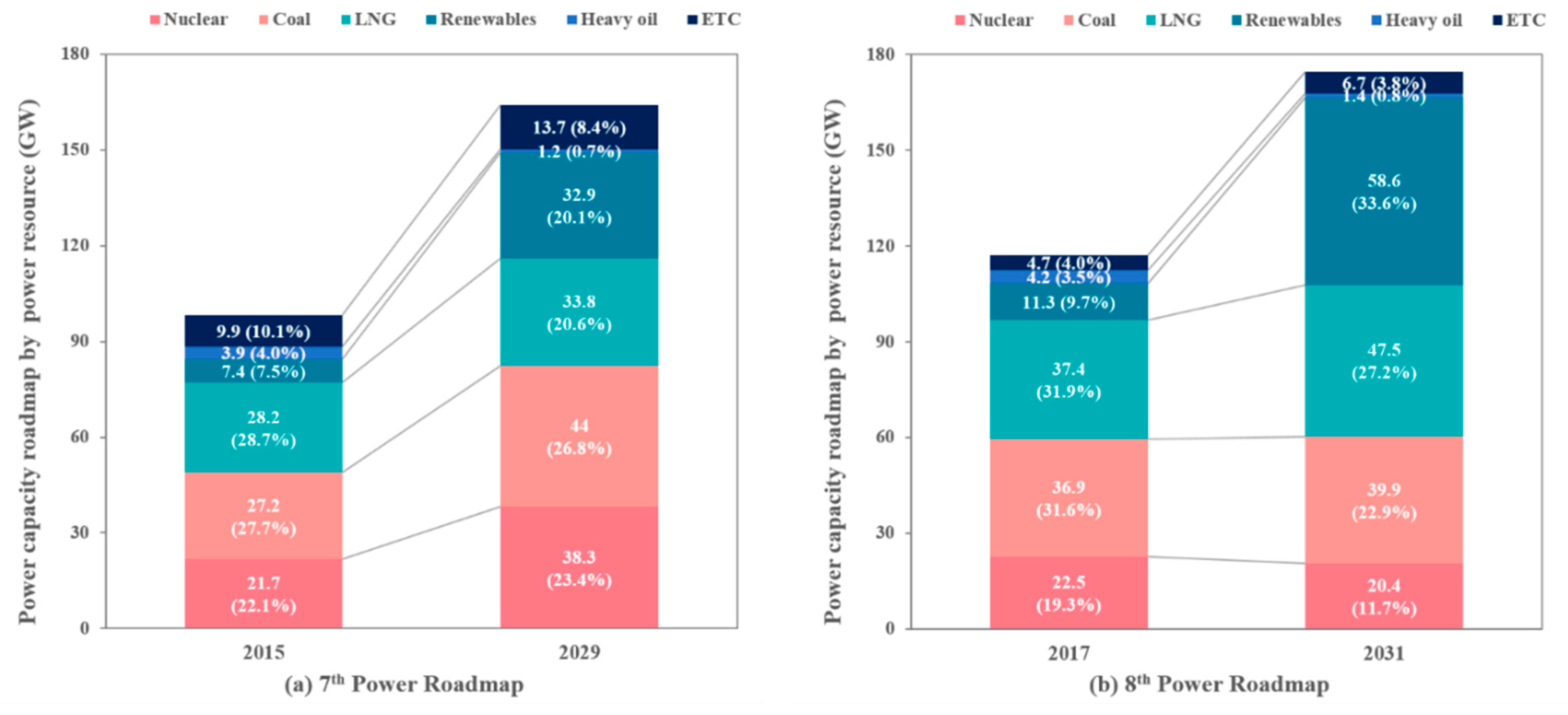


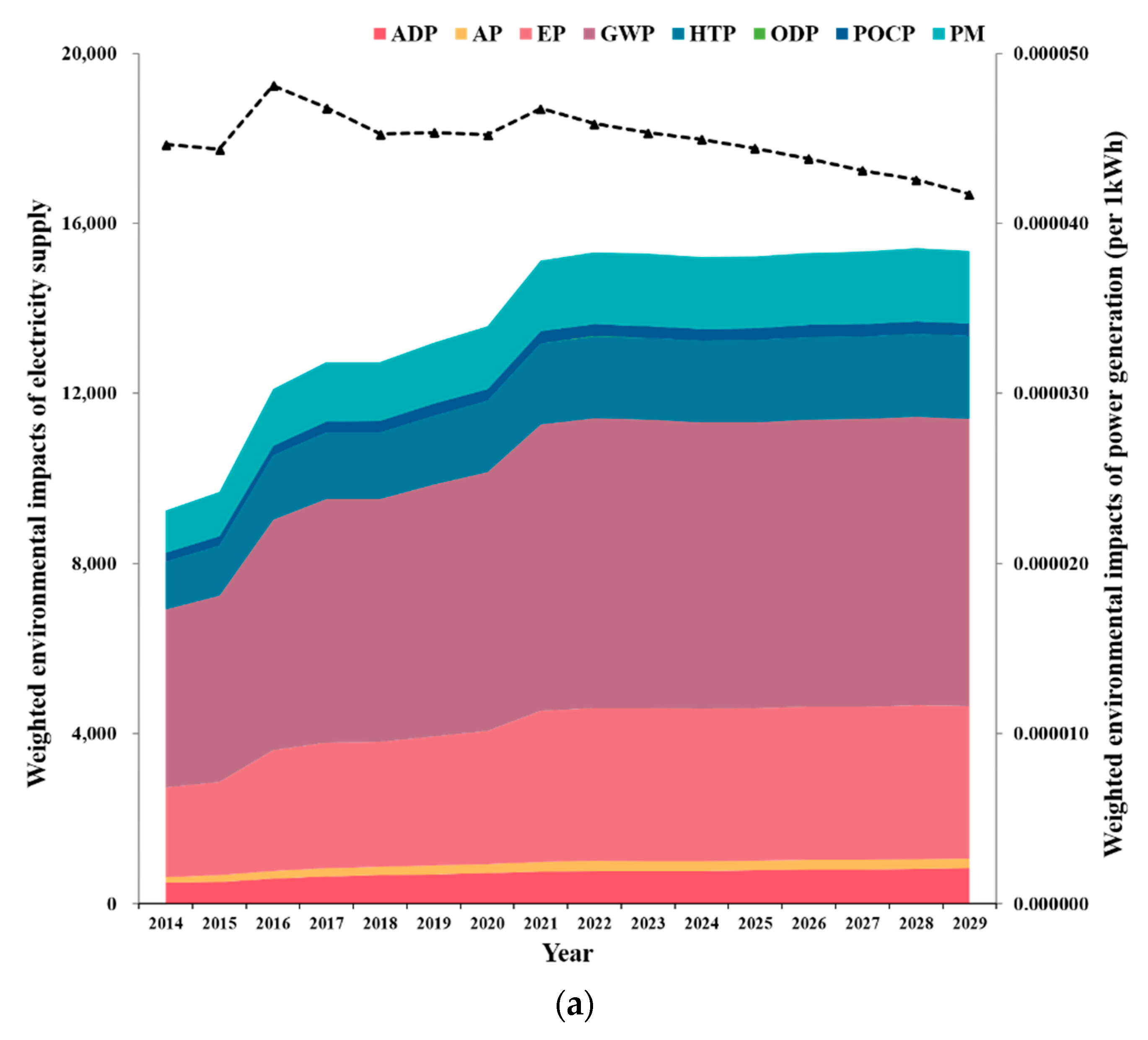
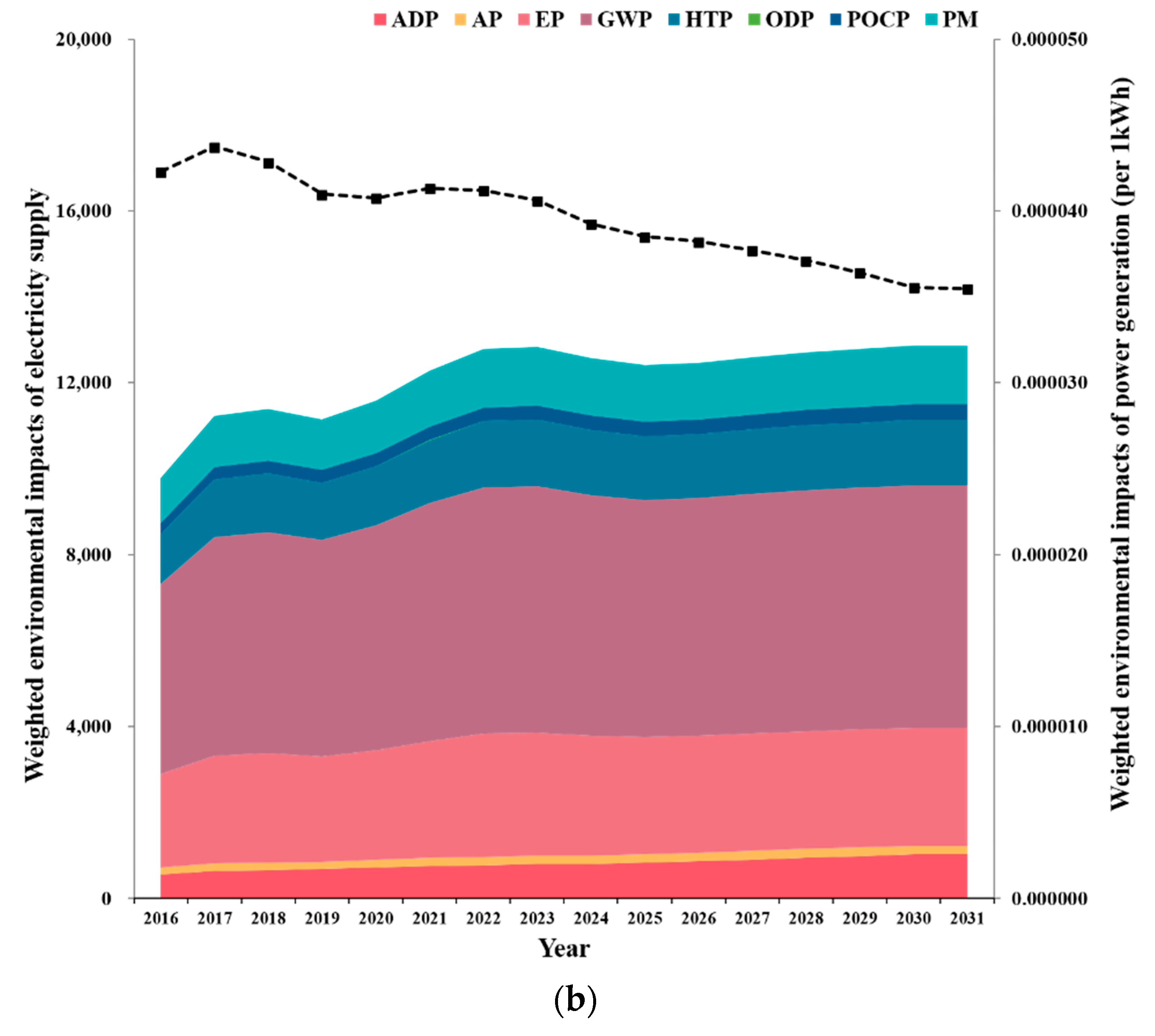
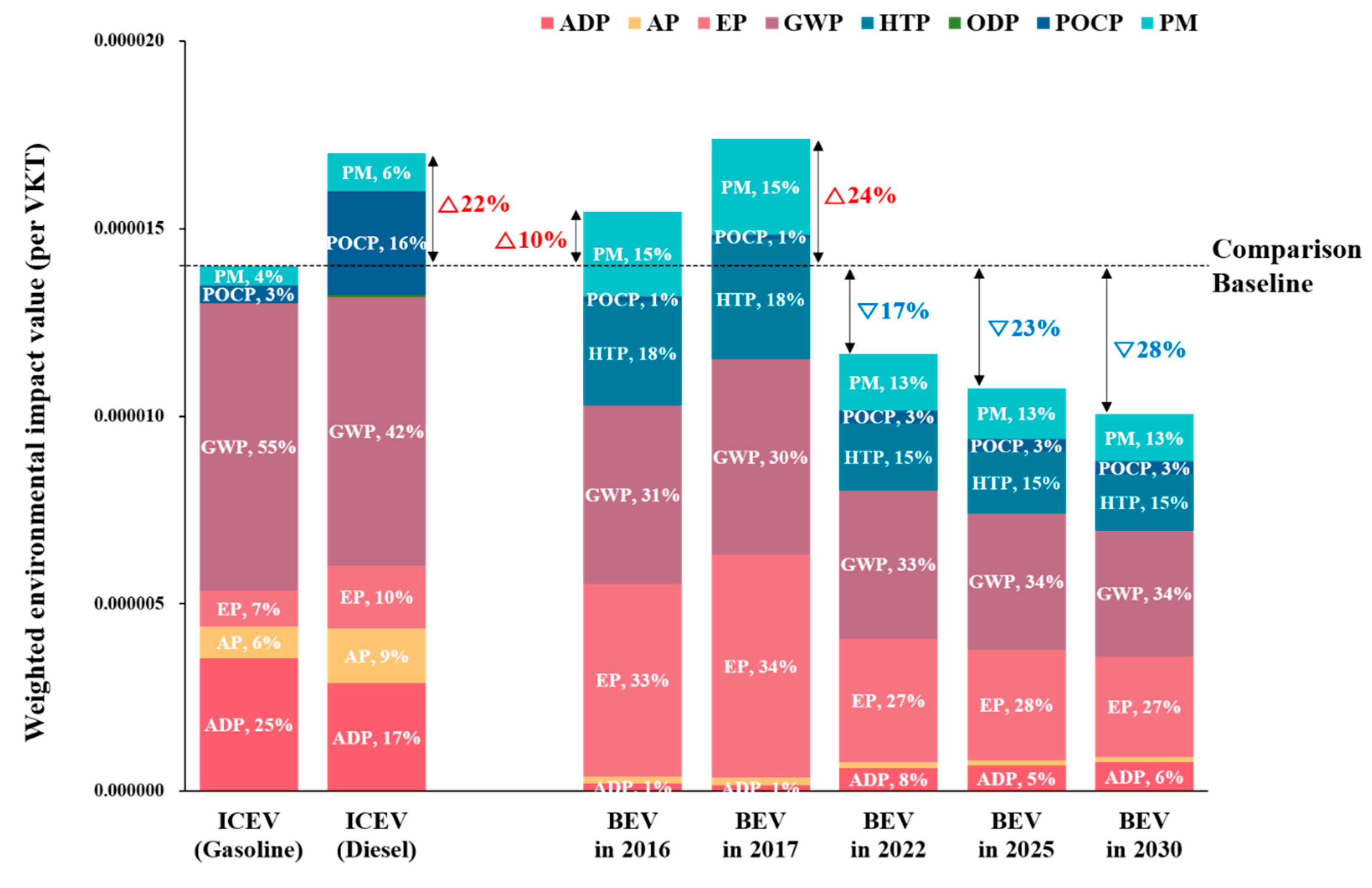
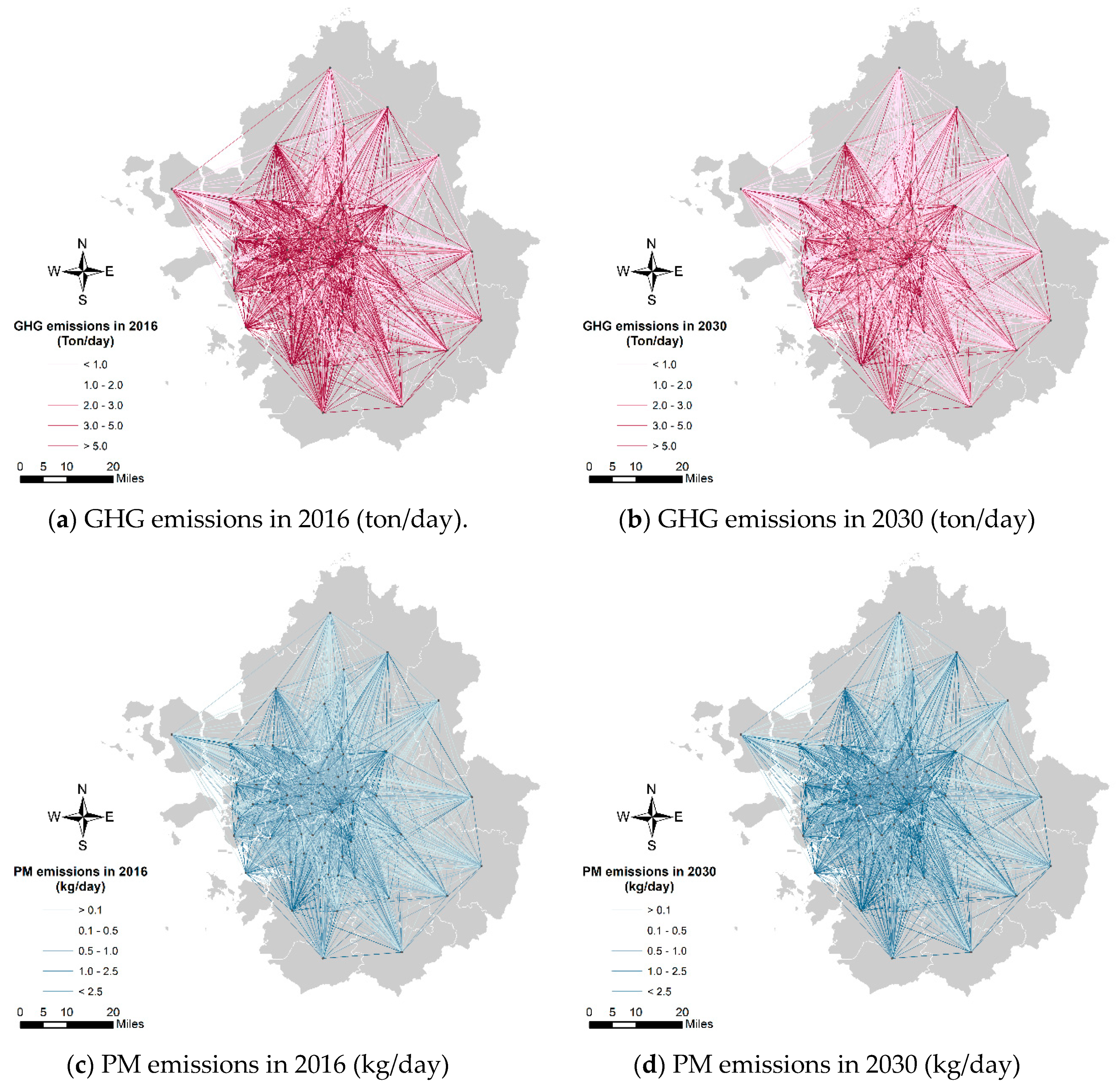
© 2019 by the authors. Licensee MDPI, Basel, Switzerland. This article is an open access article distributed under the terms and conditions of the Creative Commons Attribution (CC BY) license (http://creativecommons.org/licenses/by/4.0/).
Share and Cite
Kim, S.; Pelton, R.E.O.; Smith, T.M.; Lee, J.; Jeon, J.; Suh, K. Environmental Implications of the National Power Roadmap with Policy Directives for Battery Electric Vehicles (BEVs). Sustainability 2019, 11, 6657. https://doi.org/10.3390/su11236657
Kim S, Pelton REO, Smith TM, Lee J, Jeon J, Suh K. Environmental Implications of the National Power Roadmap with Policy Directives for Battery Electric Vehicles (BEVs). Sustainability. 2019; 11(23):6657. https://doi.org/10.3390/su11236657
Chicago/Turabian StyleKim, Solhee, Rylie E. O. Pelton, Timothy M. Smith, Jimin Lee, Jeongbae Jeon, and Kyo Suh. 2019. "Environmental Implications of the National Power Roadmap with Policy Directives for Battery Electric Vehicles (BEVs)" Sustainability 11, no. 23: 6657. https://doi.org/10.3390/su11236657





